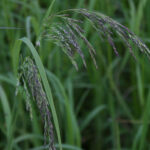Canne de bois bleue
Calamagrostis canadensis (Michx.) P. Beauv.
General Description
Bluejoint reedgrass is a robust, hardy, tall, tufted, perennial grass native to boreal forests. It gets its name from the purplish-blue nodes on its stems, and is also referred to as Canada bluejoint grass, reedgrass, marsh reedgrass, and Scribner’s reedgrass. It provides good spring forage for livestock and native ungulates. When harvested as livestock feed from wet meadows that contain significant amounts of bluejoint reedgrass, it is referred to as “beaver grass.”
Type
Native grass.
Origin
Native to boreal forests in northern Canada.
Longevity
Long-lived.
Use
Forage, revegetation, erosion control, and wildlife habitat.
Optimal Time of Use
Spring.
Recovery After Use
Decreases after heavy grazing and trampling in some areas. Otherwise, bluejoint is an increaser species and it readily reproduces through rhizomes and seed.
Palatability/Nutritional Value
Fair nutritional quality that is generally higher in early spring. Livestock generally avoid the coarse stems but will eat the large leaves.
Annual Precipitation min/max (mm)
360mm / 1650mm
Drought Tolerance
Can be very drought tolerant once established.
Flooding Tolerance
Grows well on wet soils and has high tolerance to flooding.
Winter Hardiness
High winter hardiness.
Soil Texture Preference
Often found on fine-textured soils with good water holding capacity but can be found on sandy soils with high water table. Prefers very moist to wet soils with a moderate nutrient regime.
Erosion Control
Rhizomes spread quickly in disturbed areas, and bluejoint can speed up recovery of soil properties like bulk density, organic matter content, and porosity. It has been used to lower water tables, but its competitive effect may outweigh the benefits. Bluejoint has been used to stabilize streambanks, filter runoff, increase evapotranspiration to reduce flooding, rehabilitate wetlands, and revegetate oil spills (Sourdough variety). However, if the ultimate objective is to return to natural spruce regeneration, special management of bluejoint’s highly competitive nature will be required.
Salinity Tolerance
Can tolerate mildly brackish water.
Acidity Tolerance
High tolerance. prefers pH levels of 5.0 to 5.9 and will tolerate pH down to 4.5.
Alkalinity Tolerance
Low tolerance; up to pH 8.0.
Seeds per kg
5,000,000 seeds/kg (2,270,000 seeds/lb)
Suggested Mixtures
Sometimes mixed with other grasses and legumes to reduce the competitiveness of bluejoint.
Ease of Establishment
Establishes easily from wind-blown seed or from extensive underground rhizomes. Adequate site preparation, i.e., mineral soil disturbance, is required for seeding.
Competitiveness
Can be highly competitive; mechanical or chemical control is required to control heavy swards to successfully establish tree seedlings.
Management Considerations
Proactive management is required to limit bluejoint spread in some situations. Careful scalping or large inverted mounds are mechanical controls that have been tried. Herbicides and replacement vegetation might be considered depending on the situation and management objectives. Sheep grazing with 2 grazing passes has also been used for successful control of bluejoint in the first season of tree establishment.
BC Rangeland Seeding Manual, USDA Plants Database
Bluejoint reedgrass is most adapted to the to Sub-Boreal Spruce zone in the Central Interior region.
Bluejoint is common in the native plant communities of the Peace-Liard region, often found around bogs, and in moist meadows, clearings and open forest.
